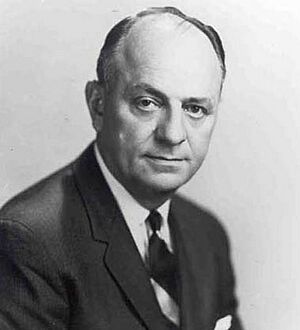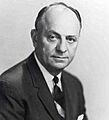Luther Terry facts for kids
Quick facts for kids
Luther Terry
|
|
|---|---|
 |
|
| 9th Surgeon General of the United States | |
| In office March 2, 1961 – October 1, 1965 |
|
| President | John F. Kennedy Lyndon B. Johnson |
| Preceded by | Leroy Edgar Burney |
| Succeeded by | William H. Stewart |
| Personal details | |
| Born | September 15, 1911 Red Level, Alabama, U.S. |
| Died | March 29, 1985 (aged 73) Philadelphia, Pennsylvania, U.S. |
| Spouse |
Beryl Janet Reynolds
(m. 1940) |
| Children | 3 |
| Education | |
Luther Leonidas Terry (September 15, 1911 – March 29, 1985) was an American doctor and important public health leader. He served as the ninth Surgeon General of the United States from 1961 to 1965. He is most famous for his strong warnings about the dangers of tobacco use and its effects on people's health.
Contents
Early Life and Education
Luther Terry was born in Red Level, Alabama. His father, James Edward Terry, was also a doctor and served as the "town doctor" for Red Level. Young Luther often helped his father in his office and even drove him to emergency calls in their family's Ford Model A car.
Luther Terry went to Birmingham-Southern College and earned a science degree in 1931. He then studied at Tulane University, where he received his medical degree in 1935. After finishing his medical training, he worked at hospitals in Birmingham and Cleveland. In 1938, he moved to Washington University in St. Louis to study pathology, which is the study of diseases. He later taught at the University of Texas at Galveston from 1940 to 1942.
Medical Career Highlights
In 1942, Dr. Terry joined the Public Health Service Hospital in Baltimore. He quickly became the Chief of Medical Services there. He was very interested in studying the heart and blood vessels. This led him to a new role in 1950 at the National Heart Institute in Bethesda, Maryland. Here, he focused on researching heart health.
When the National Institutes of Health's Clinical Center opened in 1953, Dr. Terry dedicated all his time to his research. He also taught at the Johns Hopkins University School of Medicine. His work and his team's efforts helped create a "golden era" for heart and blood vessel research.
Becoming Surgeon General
In 1958, Dr. Terry became the Assistant Director of the National Heart Institute. His public role grew when President John F. Kennedy chose him to be the Surgeon General of the Public Health Service. He started this important job on March 2, 1961.
The Landmark Smoking Report
People had always known that smoking wasn't good for you, but in the 1950s, more and more evidence showed that cigarette smoking caused serious diseases like lung cancer. In 1962, a report from the United Kingdom clearly linked smoking to lung cancer and bronchitis.
Soon after this, Surgeon General Terry created his own committee called the Surgeon General's Advisory Committee on Smoking and Health. Their job was to create a similar report for the United States. On January 11, 1964, they released their famous report, Smoking and Health: Report of the Advisory Committee to the Surgeon General of the Public Health Service.
The report clearly stated that cigarette smoking caused lung cancer and chronic bronchitis. It also suggested that smoking likely played a role in other illnesses, such as emphysema, heart disease, and different types of cancer. The committee concluded that smoking was a serious health danger that needed action.
Impact of the Report
In June 1964, the Federal Trade Commission decided that cigarette companies must put a warning on cigarette packages. This warning, which said smoking was dangerous to health, became required starting January 1, 1965. The same warning was also required in all cigarette advertisements.
Dr. Terry's report made the American public and government much more concerned about tobacco. It led to a big campaign against smoking. It also caused the tobacco industry to try harder to question the scientific evidence. The report also led to the Cigarette Labeling and Advertising Act of 1965. This law made the Surgeon General's health warnings on cigarette packages a requirement.
Later Years and Legacy
After leaving his role as Surgeon General in October 1965, Dr. Terry continued to fight against smoking. He led the National Interagency Council on Smoking and Health and worked as a consultant for groups like the American Cancer Society. He helped ban cigarette advertisements on radio and television in 1971. Later in his life, he worked to make workplaces smoke-free.
In 1965, Dr. Terry became a vice president and professor at the University of Pennsylvania. He managed the university's health science schools. He retired from this position in 1971 but continued teaching until 1975. From 1970 to 1983, he was also the president of University Associates, a nonprofit consulting firm.
Dr. Terry passed away on March 29, 1985, at the age of 73, after a heart attack. His important work changed how people viewed smoking and helped improve public health in the United States. A collection of his papers is kept at the National Library of Medicine in Bethesda, Maryland.
Images for kids



